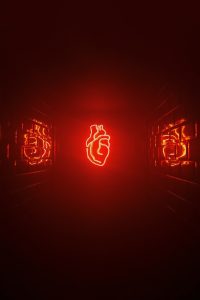Heart attack
Heart attack otherwise known as a myocardial infarction , is caused by the infarction tissue death to the heart muscle when the blood flow diminishes or completely stops in one of the coronary arteries of the heart. The most common symptom is retrosternal chest pain or discomfort classically radiating to the left shoulder, arm, or jaw. Pain might sometimes resemble heartburn. Chest pain, often radiating and may or may not be accompanied with other symptoms such as sweating, is the most frequent and meaningful symptom of myocardial infarction.

The common signs of acute myocardial infarction are chest pains described as tightness or pressure that squeezes in by patients. Pain radiates most often to the left arm, but may also radiate to the lower jaw, right arm, back, and upper abdomen. The pain most suggestive of an acute MI, with the highest ratio, is pain radiating to the right arm and shoulder. Similarly, chest pain similar to a previous attack is also suggestive. Pain with MI is generally not localized, non-anginal related and more than 20 minutes in duration. It may be squeezing, tightness, knifelike, tearing, burning pain which is also seen with other diseases.
Common symptoms of heart attack
Less common symptoms include weakness, dizziness, palpitations, and abnormal heart rate or blood pressure. These manifestations are probably caused by an overwhelming catecholamine release from the sympathetic nervous system, which is triggered by pain and, when present, hypotension. Impaired cerebral perfusion is a cause of loss of consciousness in heart attack cardiogenic shock and sudden death, which often results from the establishment of ventricular fibrillation. If the brain is left out of oxygen for a very long period of time, resulting from a heart attack, then it could lead to a coma and a persistent vegetative state.
Risk factors of heart attack
Many risk factors for heart attack overlap with coronary artery disease, which is the major cause of myocardial infarction, while the remaining risk factors include male gender, low level of physical activity, past family history, obesity, and alcohol use.
Diet of heart attack
There is mixed evidence in the context of saturated fats and how they contribute to heart attack. Studies have linked the reduction of saturated fat intake or the replacement with polyunsaturated fat consumption to be inversely linked with lower risk of developing heart attack, however, other analyses found insignificant evidence that suggests a limitation in the efficacy of these dietary changes reducing intake of saturated fats while increasing their polyunsaturated counterparts towards reducing heart attacks. Dietary cholesterol does not appear to contribute significantly to circulating blood cholesterol and thus intake levels need not be recommended limits.

The risk for an attack of myocardial infarction increases with old age low levels of physical activity or low socioeconomic conditions. Older age, active smoking, high blood pressure, diabetes mellitus, total cholesterol, and high-density lipoprotein levels are the highest risk factors for myocardial infarction.
Effect by Air pollution
Air pollution also serves as another modifiable risk of heart attack. Exposure to air pollution in short term such as that caused by carbon monoxide, nitrogen dioxide, and sulfur dioxide but not by ozone has been associated with MI and other acute CV events. For sudden death, an increase of every 30 units in the Pollutant Standards Index accounted for 8% rise in the risk of occurrence of out-of-hospital cardiac arrest on the particular day of exposure.
Etymology of heart attack
Plaques may become unstable, rupture, and further stimulate the development of a blood clot that occludes the artery this happens in minutes. Obstruction of an artery may lead to tissue death in tissue supplied by that artery. Atherosclerotic plaques are typically found for decades before they precipitate symptoms.
It is referred to as atherosclerosis, and it occurs by gradual build-up of cholesterol and fibrous tissue in plaques in the wall of the coronary arteries or other arteries. This generally happens over several decades. Inflammation of the arterial walls becomes progressive, along with the deposition of inflammatory cells primarily macrophages, in the walls of affected arteries. The latter become filled with products of cholesterol, particularly LDL, and foam cells eventually occur. On death of these foam cells, the center of a plaque acquires a cholesterol core.
With growth factors produced by macrophages, smooth muscle cells, and many other cells infiltrating the plaque, they will promote its stabilization. A stabilized plaque may be associated with a thick calcified fibrous cap. In an environment of continued inflammation, the cap may be either thin or ulcerate. Because of the blood rushing through it, the plaques-those with thin lining mostly-are likely to rupture with the formation blood clot. The cholesterol crystals were said to cause rupture through mechanical stress and inflammation in plaques.
Preventing Heart Attack
There is a high overlap between the lifestyle and activity advice for preventing heart attack and those that could be used as secondary prevention after a first-time heart attack because of common risk factors and the goal of reducing atherosclerosis involving heart blood vessels. The influenza vaccine also seems to offer protection against myocardial infarction with a benefit of 15 to 45%.

daily routine
The risk of cardiovascular disease is reduced through physical activity. Those who are at risk are often recommended to perform moderate or vigorous-intensity aerobic activity for 150 minutes a week. Reducing the risk for cardiovascular disease can be achieved through a healthy weight, alcohol intake in amounts not exceeding the limits recommended, and smoking abstinence.
Aspirin has been researched to the fullest in individuals at risk of developing a heart attack. There is no apparent benefit which outweighs the risk of excess bleeding in numerous studies conducted in different groups of people with or without diabetes. However, several clinical practice guidelines still recommend aspirin for primary prevention and some researchers think that those at very high cardiovascular risk but low risk of bleeding should continue on aspirin.
Some studies suggest that substituting unsaturated fats like olive oil and rapeseed oil instead of saturated fats would decrease the incidence of myocardial infarction, but no mutual consent.
Some national authorities suggest dietary adjustments, like higher intake of whole-grain starch, reduction of sugars, especially of refined sugars, five portions of fruit and vegetables daily, two or more portions of fish per week, and four to five portions per week of unsalted nuts, seeds, or legumes. The best-supported diet is the Mediterranean diet. No benefit is established for vitamins and mineral supplements, nor for plant stanols or sterols.
